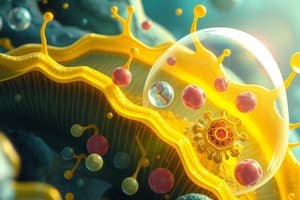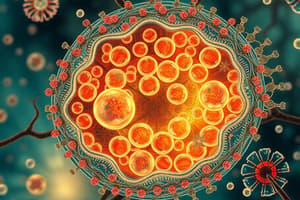Podcast
Questions and Answers
Which component of the cell is primarily responsible for synthesizing lipids?
Which component of the cell is primarily responsible for synthesizing lipids?
- Smooth ER (correct)
- Golgi body
- Mitochondria
- Rough ER
What is the primary function of the nucleus in a cell?
What is the primary function of the nucleus in a cell?
- Control of growth and metabolism (correct)
- Regulation of cell membrane permeability
- Protein synthesis
- Energy production
What is the role of ribosomes in cellular function?
What is the role of ribosomes in cellular function?
- Regulating cell division
- Translating mRNA into proteins (correct)
- Packaging and modifying proteins
- Generating ATP
How does the cell membrane contribute to cellular homeostasis?
How does the cell membrane contribute to cellular homeostasis?
Which organelle is known as the powerhouse of the cell?
Which organelle is known as the powerhouse of the cell?
What is the primary role of the endoplasmic reticulum in a cell's function?
What is the primary role of the endoplasmic reticulum in a cell's function?
Which statement about mitochondrial function is correct?
Which statement about mitochondrial function is correct?
Which of the following organelles is involved in the processing and packaging of proteins?
Which of the following organelles is involved in the processing and packaging of proteins?
What primarily distinguishes mature red blood cells from other human cells regarding organelles?
What primarily distinguishes mature red blood cells from other human cells regarding organelles?
Which function is NOT associated with the cell membrane?
Which function is NOT associated with the cell membrane?
How do ribosomes contribute to cellular processes?
How do ribosomes contribute to cellular processes?
What best describes the function of smooth endoplasmic reticulum?
What best describes the function of smooth endoplasmic reticulum?
What is the function of the cell membrane in maintaining homeostasis?
What is the function of the cell membrane in maintaining homeostasis?
Which of the following correctly states the relationship between the nucleus and the cell cycle?
Which of the following correctly states the relationship between the nucleus and the cell cycle?
Which cellular structure serves as the primary site of macromolecule modification and sorting within the cell?
Which cellular structure serves as the primary site of macromolecule modification and sorting within the cell?
Flashcards are hidden until you start studying
Study Notes
Nucleus
- The nucleus is the control center of most human cells.
- It contains the cell's genetic material (DNA).
- The nucleus regulates gene expression and mediates the replication of DNA during the cell cycle.
- Mature red blood cells lack a nucleus.
Endoplasmic Reticulum (ER)
- The ER is a network of membranous tubules and sacs involved in protein and lipid synthesis.
- Rough ER is studded with ribosomes, facilitating protein synthesis.
- Smooth ER is responsible for lipid synthesis and detoxification processes.
Mitochondria
- Mitochondria are the powerhouses of the cell.
- They generate ATP through cellular respiration.
- They play vital roles in energy production, cell cycle regulation, and apoptosis (programmed cell death).
Cell Membrane (Plasma Membrane)
- The cell membrane surrounds the cytoplasm and organelles.
- It acts as a protective barrier.
- It regulates the passage of substances into and out of the cell through selective permeability.
- This selective permeability is crucial for maintaining cellular homeostasis and communication with the external environment.
Golgi Apparatus (Golgi Body)
- The Golgi apparatus is a stack of membrane-bound sacs.
- It processes, modifies, and packages proteins and lipids synthesized in the cell.
- It sorts and directs these molecules to their appropriate destinations within the cell or for secretion outside the cell.
Ribosomes
- Ribosomes are cellular structures composed of RNA and proteins.
- They translate messenger RNA (mRNA) sequences into amino acid chains, facilitating protein synthesis.
- Ribosomes can be found either floating freely in the cytoplasm or attached to the endoplasmic reticulum (forming rough ER).
Nucleus
- The nucleus is the control center of the cell, containing DNA and regulating growth, metabolism, and reproduction.
- It is a membrane-bound organelle present in most human cells.
- Mature red blood cells lack a nucleus.
- The nucleus regulates gene expression and mediates DNA replication during the cell cycle.
Endoplasmic Reticulum (ER)
- A network of membranous tubules and sacs that synthesize proteins and lipids.
- Rough ER has ribosomes attached, involved in protein synthesis.
- Smooth ER lacks ribosomes, involved in lipid synthesis and detoxification.
Mitochondria
- The powerhouses of the cell, generating ATP through cellular respiration.
- Membrane-bound organelles with crucial roles in energy production, cell cycle regulation, and apoptosis.
Cell Membrane
- Also known as the plasma membrane, surrounds the cell's cytoplasm and organelles.
- Serves as a protective barrier and regulates the passage of substances into and out of the cell.
- Controls selective permeability, maintaining cellular homeostasis and communication with the external environment.
Golgi Body
- A stack of membrane-bound sacs responsible for processing, modifying, and packaging proteins and lipids.
- Sorts and directs these molecules to their appropriate locations within the cell or for secretion outside the cell.
Ribosomes
- Cellular structures composed of RNA and proteins, responsible for protein synthesis.
- Translate messenger RNA (mRNA) sequences into amino acid chains.
- Found floating freely in the cytoplasm or attached to the endoplasmic reticulum (forming rough ER).
Studying That Suits You
Use AI to generate personalized quizzes and flashcards to suit your learning preferences.




